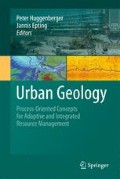Abstract
Generally open space in urban areas is very rare. Therefore, the subsurface is used more frequently for the growth of city infrastructure and traffic lines. Such constructions can temporarily affect urban groundwater systems during the construction period and permanently after completion. Subsurface constructions inevitably increase the pressure on urban groundwater resources and often result in a reduction of cross-sectional groundwater flow and aquifer-storage capacities.
Whereas rules for land and surface resource management exist, rules for subsurface planning and management (e.g., “invisibility” of water resources or geothermal energy) are almost absent. This chapter summarizes the settings in urban environments and highlights how they differ from rural areas. Further we focus on infrastructure development and use conflicts in urban areas, legal and technical backgrounds as well as the general settings of the described case studies.
Access this chapter
Tax calculation will be finalised at checkout
Purchases are for personal use only
References
Allenbach RP, Wetzel A (2006) Spatial patterns of Mesozoic facies relationships and the age of the Rhenish Lineament: a compilation. Int J Earth Sci (Geol Rundsch) 95:803–813. doi:10.1007/s00531-006-071-0
EEA (1999) Environment in the European Union at the turn of the century. European Environment Agency, Copenhagen, Denmark
Eiswirth M, Hötzl H, Cronin A, Morris B, Veselič M, Bufler R, Burn S, Dillon P (2003) Assessing and improving sustainability of urban water resources and systems. RMZ Mater Geoenviron 50:117–120
Hann HP, Sawatzki G (2000) Neue Daten zur Tektonik des Südschwarzwaldes. Jber Mitt Oberrhein Geol Ver 82:363–376
Kind F (2002) Development of microzonation methods: application to Basel, Switzerland, Ph.D. thesis, ETH Zürich, Available in electronic form from http://www.ethbib.ethz.ch
Noack T, Fäh D, Kruspan P (1999) Erdbebenmikrozonierung für den Kanton Basel-Stadt. Geologischer Bericht Nr. 24, Landeshydrologie und -geologie, 83p
Prokop G (2003) Sustainable management of soil and groundwater resources in urban areas. In: Proceedings of the 2nd IMAGETRAIN cluster meeting, Krakow, Poland, 2–4 Oct 2002
Author information
Authors and Affiliations
Corresponding author
Editor information
Editors and Affiliations
Rights and permissions
Copyright information
© 2011 Springer Basel AG
About this chapter
Cite this chapter
Huggenberger, P., Epting, J. (2011). Settings in Urban Environments. In: Huggenberger, P., Epting, J. (eds) Urban Geology. Springer, Basel. https://doi.org/10.1007/978-3-0348-0185-0_2
Download citation
DOI: https://doi.org/10.1007/978-3-0348-0185-0_2
Published:
Publisher Name: Springer, Basel
Print ISBN: 978-3-0348-0184-3
Online ISBN: 978-3-0348-0185-0
eBook Packages: Earth and Environmental ScienceEarth and Environmental Science (R0)

